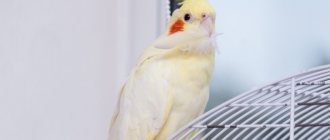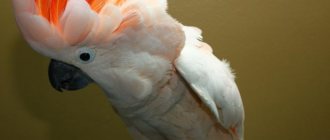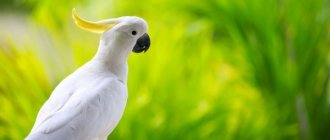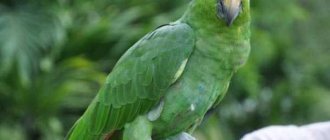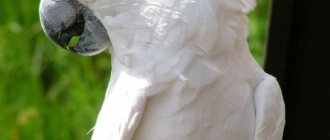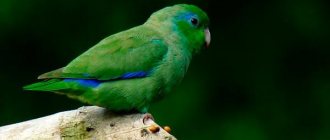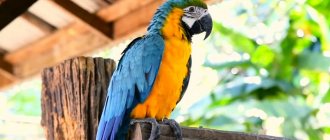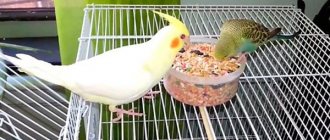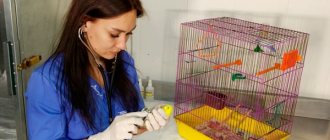The exotic and expensive cockatoo is the object of dreams of many parrot lovers. The birds gained such popularity due to their external splendor and conversational talent. Those who are planning to get such a luxurious pet cannot do without knowing how much a cockatoo parrot costs. This is an important point, because the cost of rare breeds can be comparable to the prices of cars. The article talks about what the costs of buying a crested parrot are. In addition, average prices for cockatoos of common and rare breeds are given.
What influences price formation
The question: “How much does a cockatoo parrot cost” quite reasonably arises after meeting a feathered representative of the Australian fauna. It should be immediately noted that the price is quite high. Its formation is influenced by a number of factors:
- Bird breed. In total there are about 300 species. Among this diversity there are inexpensive representatives, and there are also elite birds.
The price range is from 40 to 750 thousand rubles.
- Age of the bird. A young cockatoo is most expensive compared to a chick or an older relative.
- Parrot training. Here the price progresses along with his abilities and the results of education (training).
What does the price depend on?
The cost of a cockatoo parrot is influenced by several factors:
- Age of the bird. A chick is relatively cheap before its first moult. He still needs to be fed and educated, and this will require a lot of effort, money and time. A young cockatoo is valued higher, but an adult, sexually mature parrot is more difficult to sell. A bird with established habits and character is more difficult to raise and tame, so older birds cost less and the demand for them is lower.
- Type of feeding. The chick, which was separated from its parents at birth, grows up under the care of a person and becomes very attached to it. He adapts faster to new conditions. A parrot raised by feathered parents costs less.
- Level of intelligence and training. Obviously, a talking parrot will cost more than a bird with limited abilities.
- Availability of documents. Rare breeds of parrots, which include cockatoos, are bred in nurseries, which means that a package of documents is prepared for each chick. The birds are banded, the necessary tests are done, and a veterinary passport is issued.
- Place of sale. Online platforms are a convenient way to choose and order a feathered pet. These could be private classifieds sites or online pet stores. You can buy a cockatoo from a private seller much cheaper than in a pet store. The highest prices are in specialized ornithological nurseries.
To a large extent, the cost of a cockatoo depends on the type of bird. Let's consider how much the most affordable breeds are valued at, and how much you will have to pay for a pet of a rare, elite species.
Approximate cost of cockatoo parrots of different breeds
The cost of an individual depends on the size of the breed. Like everything rare, unique representatives on the poultry market will cost significantly higher than their more numerous relatives. Let's compare several species of the Black-billed subfamily:
White goffina
- The white goffina is the smallest representative, and therefore the cheapest species of cockatoo, the average price is about 50-60 thousand rubles . A very beautiful bird, distinguished by its slender body, fluffy feathers, and irrepressible lively and artistic character.
Yellow-crested cockatoo
- Yellow-crested cockatoo . They can ask for it from 60 thousand and above. Snow-white color and bright yellow crest are the distinctive features of this amazing bird.
White cockatoo Alba
- The white-crested or white cockatoo Alba has an aristocratic appearance and an arrogant white crest on the back of his head. It’s unlikely to be found at a price below 150 thousand rubles
Moluccan cockatoo
- Moluccan cockatoo. The rarest, but also, without exaggeration, the most beautiful representative of the breed. The pink head with a bright red crest above the snow-white plumage of the body looks elegant and extremely exotic. A member of the elite is very expensive. Owning such a magnificent bird is possible for at least 150,000 rubles .
Palm cockatoo
- The palm or black parrot is a bird with an aggressive temperament, but an unusually impressive appearance and impressive size. The price starts from 450 thousand rubles .
Cockatoo Inka
- The most expensive representative is the Inca cockatoo (desert cockatoo or Major Mitchell's cockatoo) - an unusually graceful and elegantly beautiful parrot. As rare as it is a magnificent bird. Its price fluctuates around 750 thousand rubles .
Attention! The price rating is based on online advertisements. The cost of individual breeds can vary significantly for various reasons.
KAKADU - CACATUA
RED-TAILED COCKATOO - CALYPTORHYNCHUS MAGNIFICUSSize 52 - 62cm. The male's main color is black; the central tail feathers are black, the rest with a wide red stripe in the middle; the beak is dark gray. The female's plumage is mostly brownish-black with a large number of yellow spots on the head, neck, and middle wing coverts; feathers of the underbelly with pale yellow edges.
Habitat: western, northern, northeastern Australia.
There are 4 known subspecies:
Calyptorhynchus magnificus magnificus - about 62 cm Calyptorhynchus magnificus macrorhynchus - about 62 cm Calyptorhynchus magnificus samueli - about 52 cm Calyptorhynchus magnificus naso - about 55 cm They inhabit dense tropical forests.
They climb trees deftly, but slowly; on the ground they are very clumsy and clumsy.
They nest in tree hollows, lining the bottom with wood chips.
They are extremely rare in home keeping. They are kept by nature lovers mainly for the beautiful color of their plumage. YELLOW-EARED COCKATOO - CALYPTORHYNCHYS FUNEREUS
The parrot's length is 55-65 cm, weight up to 900 g. The male's color is mainly brown-black; breast, belly and neck feathers with yellow edges. The female is characterized by a brighter yellow color of the plumage of the ear area; more distinct brown-black spots on the tail. Juveniles resemble adult females.
They feed mainly on seeds of various trees and insect larvae. The female and male build a nest together in a hollow tree, lining it with sawdust. The female lays 1-2 eggs.
She incubates alone, and the male feeds her. Usually only one chick survives; it remains in the care of its parents for approximately 6 months. It lives in South-Eastern and Eastern Australia. The species includes 2 subspecies
.
Calyptorhynchus funereus funereus
- about 65 cm
Calyptorhynchus funereus xanthanotus
- 55-60 cm
WHITE-EARED COCKATOO - CALUPTORHUNCHUS FUNEREUS BAUDINI
Body length 56-58 cm, wing length 38 cm: weight up to 800 g. The color of the plumage is black-brown with a greenish tint, all feathers are o caimlens white and yellow. There is a white spot in the ear area, for which the parrot got its name. The tail has a transverse stripe, also white. The crest on the head consists of wide feathers. The female is similar to the male only with brighter markings. The beak is very wide, much longer than it is; in the male it is black, in the female it is bone-colored.
Lives in southwest Australia. The species includes 2 subspecies
Calyptorhynchus funereus baudini Calyptorhynchus funereus latirostris Inhabits eucalyptus forests and marra thickets. They keep in small (10-30 individuals) and large flocks (up to several thousand individuals). Until recently, they ate the hard fruits of banksia (Banksia). Currently they eat the seeds of maritime pine, Western Australian and multi-colored eucalyptus, apples and pears, marra seeds and flowers, nectar, and insect larvae. They often raid orchards. When they run away, it makes sharp cries of “wee-la.”
A couple is formed for life.
Nests in hollows of eucalyptus and marra trees. There are 1-2 eggs in the clutch, but the parents feed only one chick. The second usually dies within 48 hours of birth. The chick fledges by 10-11 weeks, but stays close to its parents all year (until the next breeding season). In nature, there are no more than 10-15 thousand individuals. Life expectancy in captivity is up to 50-60 years. BRILLIANT COCKATOO - CALUPTORHUNCHUS LATHAMI
Dimensions about 48cm. The female is smaller and more brown. Habitat: Eastern Australia. The Shiny Cockatoo is the smallest of the black cockatoos. The head, neck, and the rest of the predominant part of its body have brown-black feathers. In the lower part of the body, in the tail area, there are feathers with a red or orange-red color. The parrot's crest is small and quite inconspicuous. Adult females have extensive yellow areas of feathers on the head and neck, and in the tail there are areas of feathers with a more orange-red color with black stripes, which can become more red with age. Adult males have several yellow head feathers, and the tail feathers tend to be a brighter red color. Young birds resemble adult males, but they have more yellow feathers throughout the body, in the chest, belly, and small yellow spots on the cheeks and head.
The Shiny Black Cockatoo can be confused with the Red-tailed Cockatoo, but can be distinguished by having more brownish-black plumage on the head, neck and throughout the body. The glossy black cockatoo has a much less noticeable crest, the lower part of which is wider. More smaller in size. The habitats of the shiny cockatoo are closely related to the moist forests of causarina. The parrot feeds exclusively on Ollocasuarina seeds: in the area of distribution, birds feed only on a single variety. Sometimes their diet includes larvae living on trees. They feed in threes, less often in pairs or small groups or in large flocks of up to 50 birds. They can be easily detected by the causarina cones that feed and the crunch of falling twigs.
During the breeding season, the pair stays together until they raise the chick. The female finds a hole in the tree, prepares the nest and hatches the eggs, leaving the nest, in those cases, to get food for herself, and then only after the chick is a week old.
While the eggs are in the incubation period, the male feeds the female and the newly hatched chick.
At about four months, the young bird fledges, but still remains with its parents until the next mating season. Recently, the population of shiny black cockatoos has declined due to a reduction in the range of causarina, their usual habitat and food. Due to more frequent and severe fires in south-eastern Australia. GANG-GANG - CALLOCEPHALOH FIMBRIATUM
Size about 35cm. Sexual dimorphism is pronounced. The male's crest is dark pink. The female's head and crest are gray. The chicks are like the female, but young males have a less bright head. Their feathers are also not as bright as those of adults, often with a greenish tint. A young male can be distinguished even in very small ones: he already has several red feathers on his head. Habitat: southeastern Australia and Tasmania. Habitat: impenetrable mountain forests at altitudes up to 2300 m. Especially with old eucalyptus groves.
During winter - in open areas with trees, cultivated lands and parks. Sometimes on the outskirts of cities. In summer it prefers dry forests. Migrates relative to altitude: in summer to high mountainous forests, in winter to lower valleys or coastal areas. Populations of this bird have decreased significantly due to the loss of their usual habitat. At the moment, the territory of their residence is included in the national park system, and is thus protected. Also, being a sociable creature, this bird is attracted to people's houses and gardens. and because of his gullibility and curiosity, he often falls into the hands of poachers. This is especially true for young individuals. This cockatoo especially needs animal protein. Otherwise, the bird begins to injure itself and its partner.
Natural food: seeds (eucalyptus (especially mint) and acacia), berries (hawthorn, dogwood), conifer nuts, fruits, fleshy vegetables, insects and their larvae. Food areas are usually emptied clean. Food consumption is very economical: the bird will not fly away from the tree until it is completely left without fruit. Personality: very trusting. You can get close to a wild cockatoo and even touch it. Very funny and cheerful. But one of the most difficult species to keep in captivity, this species of cockatoo is very capricious. It happens that even with “noticeable love” among a couple, birds begin to hurt each other out of idleness. He can have fun chewing fresh branches with leaves and buds, as he does in the wild (he loves eucalyptus trees E. Macrohyncha and E. baxteri, acacias).
In captivity, it is replaced with fresh branches of hawthorn and willow. Grain mixtures should contain small grains: then the birds will have less time for masochism, and even with low-calorie food they will have to eat more often. Perhaps, when building an aviary, it should be isolated so that the birds do not see their neighbors.
For questions about purchasing parrot chicks, call tel. 8 — 903 744-08-51
You can find out more extensive information about each species of cockatoo (and other large parrots) in my book "Encyclopedia of Parrots"
Where to buy a cockatoo parrot
It is almost impossible to buy a rare breed in a regular pet store. It is better to purchase cockatoos from large specialized pet stores, professional nurseries or from trusted breeders. There are several reasons for this:
- 100% accuracy of information: place of birth, age, breed and other data;
- all birds are sold legally, have vaccinations and are guaranteed to be healthy;
- raised in the right conditions and adapted to home life;
Purchasing illegal birds at a reduced price is a dubious deal. The parrot may turn out to be wild and unadapted to training and life in captivity. The presence of serious diseases is possible.
Teaching a parrot to speak
Scientists have found that the intelligence of an adult cockatoo parrot that has undergone proper upbringing corresponds to the development level of a 3-4 year old child. He is able to learn up to a dozen words, song choruses, and individual phrases. Onomatopoeia with other representatives of the environment is well developed. But the apparent ease of learning is deceptive.
In practice, this can only be achieved through systematic training at a certain time. Experts advise working with your pet daily for 15 minutes in the morning and evening, and once a week for a lesson of up to 40 minutes.
Training will be successful if the classes are conducted by a person the bird trusts, who spends significant time with it every day.
It has been observed that cockatoos prefer teachers with high-pitched voices. In this regard, children or women are preferable.
The pet remembers the spoken words once and for all, so it is better to avoid obscene language in his presence. The bird is able to remember a phrase it hears after a couple of years and “broadcast it in direct text” in front of children or in the company of guests.
It is believed that the parrot does not understand the lexical meaning of words, but observations show the opposite. Over the years, he is able to learn the meaning and meaning of individual words and remarks, and use them for their intended purpose with the correct intonation.
It is recommended to begin speech training when the bird sits on your hand or shoulder, expressing its trust. You need to talk to her more often while playing.
Remember! The parrot is a social bird and cannot stand long periods of loneliness, which can cause serious illness.
general characteristics
The cockatoo is considered a large parrot. There are no colorful patterns in its plumage, but this parrot looks very attractive. It has a crest: narrow and elongated or fluffy, resembling a crown. The tail is short, spade-shaped. When folded, the wings cover the tail to the middle, and when spread, they reach a span of 50 cm. The powerful beak is capable of splitting hard nut shells and cutting through thick wire. The paws are dark gray in color, two toes point forward, two point back. The bird moves awkwardly, but flies quickly, and is also very good at climbing trees.
Diseases of cockatoo parrots
Parrots are susceptible to the same diseases as other birds - they suffer from inflammation of the respiratory tract (sinusitis, rhinitis), intestines (cellulitis, coccidiosis), and become infected with parasites. Ornithosis is less common. There are frequent cases of self-plucking, which is not a disease, but signals serious health problems.
The cause of most diseases is improper care, poor food and lack of attention. The latter often leads to psychological imbalance and is accompanied by increased plucking of feathers, sharp screams and aggressive bites of others. In such cases, increased care for the pet, longer communication and games help solve the problem.
In other cases, it is recommended to immediately contact a veterinarian ornithologist to establish the correct diagnosis and treatment of the disease.
Recommendations for keeping a cockatoo parrot
Keeping this type of bird requires a lot of effort and time. Caring for him is akin to caring for a small child.
Feeding
A parrot's diet must include fruits, vegetables and cereal grains. Almost everything in the list of recommended products is acceptable. The exceptions are avocados and peanuts, which are toxic to poultry. You should not feed the bird chocolate or heat-treated meat. Fatty varieties in any form are especially harmful. Periodically, the diet is varied with foods that contain protein: cheese, cottage cheese, hard-boiled eggs and well-cooked bones.
It is necessary to monitor the water in the drinking bowl and regularly change it to fresh water. It is advisable to add calcium to the feed at least once a week.
Care
Hygiene procedures include periodically bathing your pet if he does not resist this procedure, helping to clean feathers in hard-to-reach places (if he lives alone), trimming and trimming his wings, and treating his beak and claws.
Conditions of detention
The place where cockatoos are kept should be as large as possible. Recommended cage dimensions are one meter high and 70x70 at the base. Cramped conditions have a bad effect on the parrot's well-being, unless he spends most of his time outside. It is advisable to equip two perches inside the cage. The crossbars are made strong and thick, since the cockatoo easily breaks them with its powerful beak. The place should be brightly lit, but not passable, as drafts are harmful to the bird.
Distinctive features of a cockatoo
In addition to their amazing openness and friendliness, these large talking parrots attract many people. They are very easy to care for and do not require extra expenses. Owners feel very comfortable with such birds. The cockatoo is ready to constantly demonstrate affection and love for its owner. Only his owner can get tired from such a display of affection from his pet, but not the parrot himself. His warmth knows no bounds! Sometimes the cockatoo is very annoying, but all this is only from great love, and this should be understood and accepted.
This species of parrot was also not observed to be timid. By the way, the cockatoo is quite unceremonious with other pets. He is able to bark at the dog, even bark at him, because the onomatopoeic characteristics of the cockatoo are well developed. By the way, cockatoos are often not very kind to cats.
A living cockatoo has a huge beak, and with it it can open almost all locks. Therefore, you need to be careful: your pet has enough skill and ingenuity to understand the design of any lock.
Large parrots are highly trainable; it is not without reason that they are often used in circuses to demonstrate their talent. Cockatoos have a sense of rhythm and love to dance, and they do it with great pleasure. They can do any dance. There are a lot of incendiary videos on the Internet featuring feathered beauties.
Reproduction in captivity
Breeding parrots of this breed is quite a troublesome task. Beginners should carefully study this issue, consult with experienced specialists, and then find a mate for their pet. It is impossible to determine the sex of a bird by appearance; this can only be determined by conducting tests or experimentally in an aviary.
The female incubates the laid eggs (2-3) for a month. Sometimes less, it depends on the breed of cockatoo. The chicks are born helpless: they are blind and have no feathers. The eyes open after a week, and by 10 days the gaze becomes meaningful. The first feathers appear after about two weeks on the wings and the back of the head, full plumage occurs after two months.
The rarer the breed of parrot, the more difficult it is to breed it in captivity. Reproducing the population of this endangered bird species is a noble and rewarding endeavor. Buying this red book is expensive, but it will more than pay off if you are ready to devote maximum attention and time to your pet.
